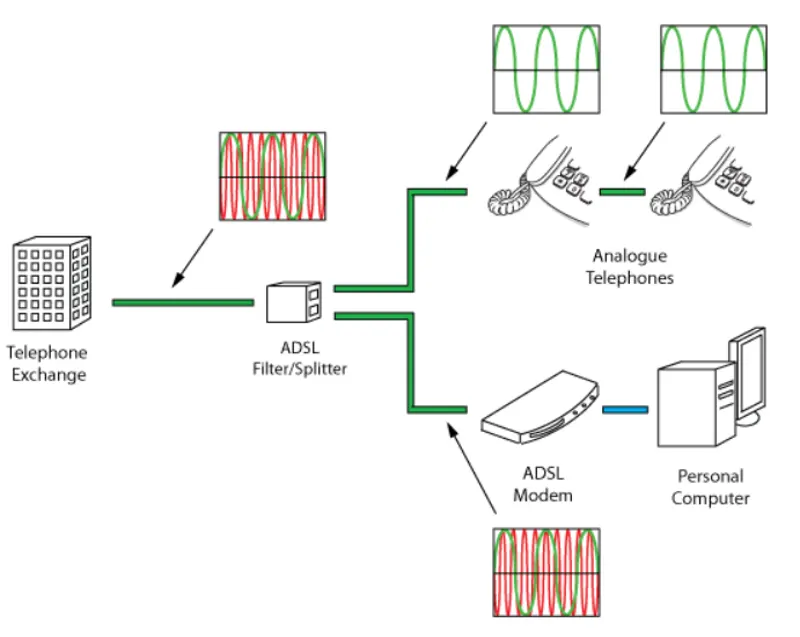ADSL Broadband
ADSL is the most widely available and cheapest broadband technology that homes and businesses in the UK utilise to connect to the internet via a tethered or wireless connection.
ADSL was at the centre of the major web 2.0 revolution of the 2000s that widely replaced the impractical dial-up connection many Millenials fondly remember for its screeching and bleeping sounds.
In this article, we give you an overview of ADSL (also known as “standard” broadband) and answer some FAQs.
💡ADSL is rapidly being replaced by fibre-optic technology, unlimited 5G wireless dongles and perhaps satellite business broadband, which all provide a much better connection.
💡ADSL is impacted by the PSTN switch off in 2027.
Contents
- What is ADSL broadband?
- How does ADSL broadband work?
- How fast is ADSL broadband?
- What can I do with an ADSL connection?
- What to look for when comparing ADSL broadband?
- ADSL vs Fibreoptic broadband
- How is ADSL broadband installed?
- When was ADSL invented?
- When is ADSL going to be phased out?
What is ADSL broadband?
ADSL is essentially the slowest and cheapest type of broadband available in the market, which allows devices in your home or business to connect to the internet at limited speeds.
It stands for Asymmetric digital subscriber line and, technically speaking, is a type of digital communications technology that enables a user to send and receive data over traditional copper telephone lines.
ADSL is asymmetrical in the sense that it can receive significantly more data than it can send, which makes it ideal for most households as people consume more data (i.e. streaming and downloading music and videos, reading articles, etc.) than they send.
In the UK, ADSL is typically referred to as “Standard Broadband”.
How does ADSL broadband work?
ADSL connects users to the internet by sending and receiving data through the UK’s copper-wire telephone line network, which is operated and maintained by Openreach.
This data transfer is managed by a modem that connects to the telephone cable socket on your premises, and an ADSL filter allows both a typical voice landline and broadband internet connection to happen simultaneously without interfering with each other.
This means that users can speak on the phone while simultaneously using the internet, unlike the pre-historic dial-up internet connections where you could only do one at a time.
How fast is ADSL broadband?
There are two different types of ADSL in the UK:
- ADSL1 typically has maximum speeds of 8MBps (<10% of ADSL lines in the UK)
- ADSL2+ typically has maximum speeds of 24MBps (>95% of ADSL lines in the UK)
However, ADSL speeds can vary widely depending on your property’s distance from telephone exchangers, which are significantly more concentrated in urban than rural areas.
You can search your property’s proximity to telephone exchangers by using this tool.
Test the speed of your internet connection with our business broadband speed test.
What can I do with an ADSL connection?
ADSL is a good option for businesses with light internet needs, such as:
- Point of sale card transactions
- Answering emails
- Using cloud-based office applications
For heavier internet usage or for businesses with multiple simultaneous users, cable or fibre optic broadband may provide the appropriate bandwidth.
Typical tasks that are inadequate for an ADSL connection include:
- Transferring large files,
- Running cloud computing or storage services,
- Having multiple devices using the internet at the same time,
- Using a reliable VoIP phone system
What to look for when comparing ADSL broadband?
Price is important when considering a new ADSL broadband provider, but it is not the only important factor. Here are a few other things to take into account when switching business broadband providers:
Alternative broadband
Check if a “Superfast” or “Ultrafast” connection is available in your postcode by using this tool by Ofcom. These types of connections are either cable or fibre optic connections and not ADSL, and in some cases, they come only with a minimal price markup for a much faster connection.
Broadband speed comparison
If you currently have an ADSL business broadband provider, it is worth doing a broadband speed test on your current connection to compare it to what other providers offer.
Just keep in mind that broadband speeds will vary depending on the day and time of measurement, so it may be worth noting the time and date of your measurement(s) and perhaps doing so during the busiest times of the day, which are 8 pm to 10 pm for home services, and 12 pm to 2 pm for business services.
Note that Ofcom regulation dictates that the minimal speeds quoted by your business broadband provider must represent the typical speeds at these busy times of the day.
Customer service
Customer service is often neglected when comparing business broadband providers, but having support for connection issues is essential.
We have all experienced frustration when the internet connection becomes unreliable, slow or stops altogether.
Use Trustpilot as part of your broadband due diligence and make sure that your chosen ADSL provider has a high “TrustScore” and positive reviews from users.
This is also a great way to ensure any provider-specific technical issues (as they provide the modems and filters) arise in advance.
Business broadband hub comparison
Comparing broadband offerings can be a little complex. The best broadband provider will typically depend on the Openreach infrastructure available at your property and the internet needs of your business.
Cut through the complexity with the help of our broadband experts and find the best:
ADSL vs Fibreoptic broadband
Essentially, ADSL is an older broadband technology that uses the existing copper telephone lines to transmit data, while fibre optic broadband relies on a new fibre optic network that is growing rapidly worldwide.
When ADSL broadband data is transmitted over copper wires, it is sent as electrical signals that are limited by the speed at which electrical signals move along the wires, while fibre optic technology transmits data much faster via signals encrypted within laser travelling at the speed of light.
This means that fibre optic networks can handle more data faster than ADSL, but the infrastructure is still unavailable everywhere and is particularly missing in rural areas.
SoGEA business broadband, full fibre business broadband and leased line broadband are the most popular types of fibre optic connections.
It is worth remembering that in the UK’s simplified broadband lingo:
- “Standard” broadband = ADSL
- “Superfast” and “Ultrafast” broadband = Fibre optic
ADSL – FAQs
In this section, we answer other FAQs that are slightly more obscure yet may answer your very specific questions!
How does an ADSL splitter work?

Essentially, both your traditional landline and ADSL use the same copper wire infrastructure that was originally installed over 100 years ago.
Before ADSL, dial-up connections were used to connect to the internet at very slow speeds while blocking the normal landline when connected to the internet. This would result in screeching and bleeping sounds on the landline while someone was connected.
ADSL technology introduced a splitter or microfilter that filtered the voice call frequencies (0-4 kHz) from the frequencies used by broadband (26- 1100 kHz), ensuring that one wouldn’t interfere with the other when used simultaneously (see diagram above).
As a result of this innovation, users could connect to the internet while simultaneously making a call.
These splitters were traditionally installed near the demarcation point of your property by technicians, but these can now be self-installed directly on any telephone cable plug.
When was ADSL invented?
ADSL was a major revolution in internet broadband connectivity that drove the web 2.0 revolution, which changed the way users interacted with the internet.
Without ADSL, broadband speeds allowing for social media, interactive web applications and more complex audio and visual streaming would not be possible, dramatically hampering the usability of the internet.
ADSL was originally patented in 1988 but took over a decade to start rolling out due to its prohibitive costs.
The ADSL rollout began in the late 1990s, primarily in developed countries, and this rapidly accelerated throughout the 2000s.
When is ADSL going to be phased out?
With the aggressive roll-out of fibre-optic broadband and improvements in wireless internet standards like 5G, many assume that ADSL connections will soon be phased out.
This is probably a correct interpretation, particularly when considering projects such as Helium 5G (p2p 5G network sharing) and OneWeb (global satellite internet), which will have global coverage by 2023.
However, with virtual warfare a possible future threat, governments and institutions may consider having a backup connection standard like ADSL available to ensure virtual resilience in case of attack.

